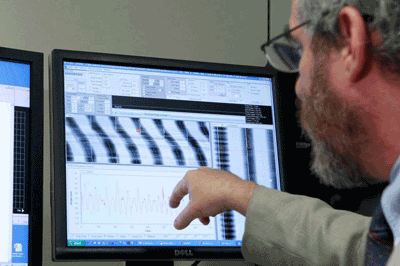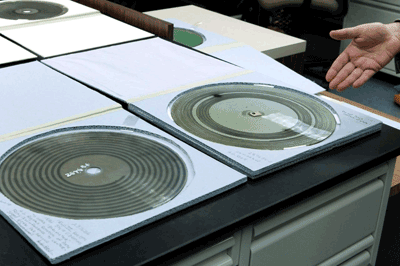New technology creates opportunity to further research early communications technology
This past Tuesday, the Library of Congress teamed up with the Lawrence Berkeley National Laboratory to decode early recordings made by Alexander Graham Bell and others from the 1880s. It is believed that this is the first time these recordings were played in nearly 130 years.

Lawrence Berkeley National Laboratory Scientist Carl Haber shows the frequencies of the sound recorded in 1885 by Alexander Graham Bell at Volta Laboratory during a news conference at the Library of Congress in Washington. (Via: AP Photo/Jose Luis Magana)
Many of these recordings, long stored at the Smithsonian, are considered very, very fragile. Until this technology became available, it had not been possible to listen to them without damaging the discs or cylinders.
First, some background
In the 1880s, Bell was part of a growing group of scientists trying to be the first to record sound. The scientists were using anything they could find, whether it was glass, rubber, or metal. With each success, Bell, along with other innovators of the time like Emile Berliner and Thomas Edison, left objects and documentation with the Smithsonian to prove their innovations were first.
While Edison’s earliest recordings are believed to be lost, Bell took extra precaution and sealed some of his devices in tin boxes for safe keeping. As a result, approximately 200 experimental records of his were safely packed away with the Smithsonian, seemingly never be played again.

Lawrence Berkeley National Laboratory Scientist Carl Haber shows a glass Alexander Graham Bell, Volta Laboratory recording, from 1884. (Via: AP Photo/Jose Luis Magana)
How’d they do it?
The technology that the Lawrence Berkeley National Laboratory developed reads the sound from tiny grooves in the material using light and a 3D camera. Software then creates a high-resolution digital map of the disc or cylinder, which is next processed to remove scratches and skips. A program then takes the map and reproduces the audio content into a standard digital sound file.
The Lawrence Berkeley National Laboratory details their research online: http://irene.lbl.gov/
So — what’d they hear?
Recordings were made on cylinders and discs of several different designs. The sounds captured include a collection of recited verse, man-made sound effects, and basic spoken information.
“To be or not to be…” a man’s voice says from a green wax disk. The speaker then goes on to recite a portion of Hamlet’s soliloquy. Researchers were also able to hear a man announce the date of the recording, “It’s the eleventh day of March, eighteen hundred and eighty five,” he said.
Later on, a man’s voice is heard saying, “Mary had a little lamb and its fleece was white as snow . . . Everywhere that Mary went — oh no!”
A second recording, this one on a copper negative disc, hears someone trilling their tongue, and then reciting the numbers, “1, 2, 3, 4, 5, 6.”
A third recording was not as well rehearsed as the others, as it appears to have caught Bell’s disappointment when he realized that his recording device hit a technical glitch.
Hear it for yourself
You can hear the recordings here: http://bio16p.lbl.gov/
What does this all mean?
In total, it took about 10 years and approximately $1 million to create this technology. Now that it works, it’s believed that the Smithsonian’s collection of approximately 400 early recordings (including the 200-or-so from Bell’s lab) will become a key resource for new research on communications and early technology.■
The AP first reported this story: http://www.google.com/hostednews/ap/article/ALeqM5gxbYM0QeRgYEZ6NBSsjlLNisXssQ?docId=1de2ca27653f4b51997a10b6967ce709
Advertisement
Learn more about Electronic Products Magazine





